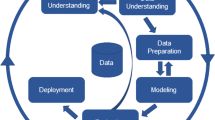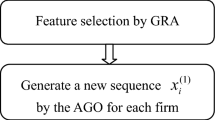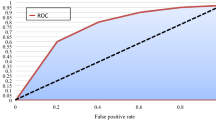Abstract
The fast development in China’s economy has caused the rapid expansion of the domestic market. Since many economists do not have optimistic views regarding the bubble economy of China, it is necessary for Taiwanese businessmen to understand in-depth the business operational performance and financial situation of enterprises in China, so as to reduce the risk of a potential investment. In this article, data from the China Economic Research Database (CCER), the financial database of financial corporations are collected for analysis to investigate the business operation and management performance and financial characteristic of enterprises in China. In this article, grey relational analysis is applied first in order to investigate the business operational performance of 600 enterprises in China. Afterwards, a more recent clustering technique is used to divide, based on financial characteristic, enterprises in China into two groups. Finally, three models, namely genetic programming, Back-Propagation Neural Network and Logistic Regression are adopted to construct an Enterprise Operational Performance model and an Enterprise Finance Characteristic model, respectively. Based on the results found, it can be concluded that genetic programming yielded the best classification and forecast performance, compared to the other three techniques.
Similar content being viewed by others
References
Dain RA (1998) Developing mobile robot Wall-Following algorithms using genetic programming. Appl Intell 8(1):33–41
Wu CH, Tsai CH (2008) Robust classification for spam filtering by back-propagation neural networks using behavior-based features. Appl Intell 31(2):107–121
Jang GS, Lai F, Jiang BW, Parng TM, Chien LH (1993) Intelligent stock trading system with price trend prediction and reversal recognition using dual-module neural networks. Appl Intell 3(3):225–248
Deng J (1982) The control problems of grey system. Syst Control Lett (5):288–294
Lin CT, Chi LW, Chiu YS (1996) The application of grey relational analysis in physical education training. Thesis. In: the first grey system theory and application forum, pp 333–340
Wang YJ (2006) Applying grey relation analysis to find the representative indicators of financial ratios for evaluating financial performance of container shipping companies on Taiwan. Marit Q 15(1):1–17
Lin SY (2004) Evaluation of business reputation in information service industry-an application of grey relational analysis. J Inf Technol Soc (2):79–95
Huang SJ, Chiu NH, Chen LW (2008) Integration of the grey relational analysis with genetic algorithm for software effort estimation. Eur J Oper Res 188(3):898–909
Wang CH, Hsu LC (2008) Using genetic algorithms grey theory to forecast high technology industrial output. Appl Math Comput 195(1):256–263
Bahrampour S, Moshiri B, Salahshoor K (2010) Weighted and constrained possibilistic C-means clustering for online fault detection and isolation, Appl Intell. doi:10.1007/s10489-010-0219-2. Available online 13 March 2010
Gustafson DE, Kessel WC (1979) Fuzzy clustering with fuzzy covariance matrix. In: Proceedings of the IEEE CDC, San Diego, pp 761–766
Koza JR (1992) Genetic programming I: on the programming of computers by means of natural selection. MIT Press, Cambridge
Koza JR (1992) Genetic programming II: automatic discovery of reusable programs. MIT Press, Cambridge
Holland J (1975) Adaptation in natural and artificial systems. University of Michigan Press, Ann Arbor
Wen KL, Chang-Chien SK, Yeh CK, Wang CW, Lin HS (2006) Apply MATLAB in grey system theory. Chuan Hwa Book CO, Ltd
Yeh YC (2001) The model application and practice of artificial neural network, Scholars Books Co, Ltd
Liu L, Xu W (2006) UOFC-AINet: A fuzzy immune network for unsupervised optimal clustering, cimca. In: International conference on computational intelligence for modelling control and automation and international conference on intelligent agents web technologies and international commerce (CIMCA’06), p 196
Bensaid AM, Hall LO, Bezdek JC, Clarke LP, Silbiger ML, Arrington JA, Murtagh RF (1996) Validity-guided (Re) clustering with applications to image segmentation. IEEE Trans Fuzzy Syst 4:112–123
Xie XL, Beni GA (1991) Validity measure for fuzzy clustering. IEEE Trans Pattern Anal Mach Intell 3(8):841–846
Bradley AP (1997) The use of the area under the ROC curve in the evaluation of machine learning algorithms. Pattern Recognit 30(7):1145–1159
Hand DJ, Till RJ (2001) A simple generalisation of the area under the ROC curve to multiple class classification problems. Mach Learn 45(2):171–186
Author information
Authors and Affiliations
Corresponding author
Rights and permissions
About this article
Cite this article
Pan, WT. The use of genetic programming for the construction of a financial management model in an enterprise. Appl Intell 36, 271–279 (2012). https://doi.org/10.1007/s10489-010-0259-7
Published:
Issue Date:
DOI: https://doi.org/10.1007/s10489-010-0259-7




